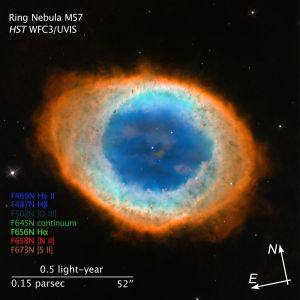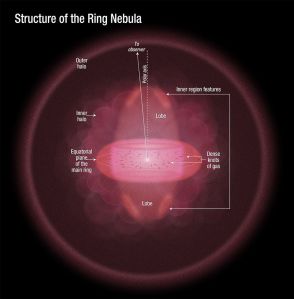
Credit: NASA, ESA, C.R. Robert O’Dell (Vanderbilt University), G.J. Ferland (University of Kentucky), W.J. Henney and M. Peimbert (National Autonomous University of Mexico)
Credit for Large Binocular Telescope data: David Thompson (University of Arizona)
This new image of the Ring Nebula is actually a composite image, composed of both visible and infrared sources. The combined images come from the Hubble Space Telescope and the ground-based Large Binocular Telescope.
The Ring Nebula (M57) has long been a picture of the beauty of space and stellar explosions, often found in many textbooks and presentations for its “ooh and ahh” factor. It is visible through many amateur telescopes (apparent magnitude 8.8), and was the second planetary nebula to be discovered by Antoine Darquier de Pellepoix in 1779, who beat Messier to it by a few days.
This new view of the nebula reveals a more complex shape than it was once thought to have. In the center lies the remnant of the once red giant star, a white dwarf. The blue structure is glowing helium that is excited by radiation from the white dwarf.
A sun-like star becomes a planetary nebula when it has reached the end of its life during the red giant phase. The outer layers of the star are then ejected outwards into space by stellar winds and pulsations. Once the star has shrugged off its outer layers only the radiation emitting core remains, which causes the expelled shells of gas to glow.
Planetary nebula have an important role in the universe. They send enriched material back into the interstellar medium, which contributes to the chemical evolution of galaxies.
More Images of the Ring Nebula:


It’s amazing! It is just looks like an eye.
Pingback: Am I feeling Stellar or just Out there?? | Thru the eyes of a Dragyn·